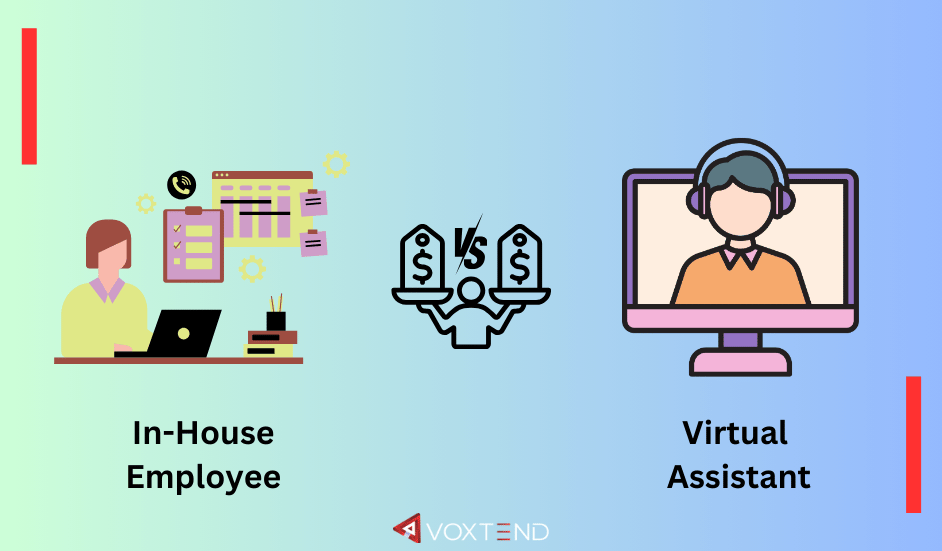Businesses today have more options than ever when it comes to hiring talent. Two popular choices are hiring in-house employees and employing virtual assistants (VAs). Each option comes with its own set of costs, benefits, and challenges. In this blog, we’ll explore the cost differences between in-house employees and virtual assistants, helping you decide which is the best fit for your business needs.
What is an In-House Employee?
An in-house employee is someone who works directly for your company and is usually based in your physical office. They work set hours and are part of your company’s culture, attending meetings, participating in team activities, and working closely with other employees.
What is a Virtual Assistant?
A virtual assistant (VA) is a specialist who works remotely to help clients with administrative, technical, or creative needs. They can work from anywhere in the world, often on a freelance or contract basis. Instead of working a set number of hours, companies typically hire VAs to perform specific tasks or projects.
Cost Factors for In-House Employees
Hiring in-house employees involves several costs, some of which are direct, while others are indirect. Here’s a detailed look at the various costs associated with in-house employees:
1. Salaries and Wages
- Base Salary: The most obvious cost is the employee’s salary. This varies widely depending on the role, experience, and location.
- Overtime Pay: If employees work beyond their standard hours, you might need to pay overtime, which can add significantly to labor costs.
2. Benefits
- Health Insurance: Many companies provide health insurance, which can be a substantial cost.
- Retirement Plans: Fund contributions made to US retirement plans such as 401(k).
- Paid Time Off: Vacation days, sick leave, and other forms of paid time off also contribute to the total expense.
3. Office Space and Utilities
- Office Rent: Providing physical office space for employees incurs rental costs.
- Utilities: Electricity, water, internet, and other utilities are necessary to keep the office running.
4. Equipment and Supplies
- Office Equipment: Computers, desks, chairs, and other office furniture are essential for in-house employees.
- Supplies: Pens, paper, and other office supplies are small but ongoing costs.
5. Training and Development
- Training Programs: Investing in the training and development of employees to improve their skills and productivity.
- Onboarding Costs: Time and resources spent on integrating new hires into the company.
6. Miscellaneous Costs
- Taxes: Employer payroll taxes, including Social Security and Medicare in the U.S.
- Insurance: Workers’ compensation and liability insurance.
- Recruitment: Costs related to advertising job openings, recruitment agencies, and the time spent on interviewing candidates.
Cost Factors for Virtual Assistants
Employing virtual assistants can be more flexible and cost-effective compared to in-house employees. Here are the key cost factors associated with virtual assistants:
1. Hourly Rates or Project Fees
- Hourly Rates: Many VAs charge by the hour, with rates varying based on their skills and experience.
- Project Fees: Some VAs charge a flat fee for completing specific projects or tasks.
2. No Benefits
- No Health Insurance: Unlike in-house employees, VAs are responsible for their own health insurance.
- No Retirement Plans: VAs handle their own retirement savings.
3. No Office Space or Utilities
- Remote Work: VAs work remotely, so there are no costs associated with providing office space, utilities, or office equipment.
4. Minimal Training and Development
- On-Demand Skills: Employers typically hire VAs based on their pre-existing skills, resulting in a reduced investment in training and development.
- Quick Onboarding: Onboarding a VA is usually faster and less resource-intensive compared to in-house employees.
5. No Miscellaneous Costs
- No Payroll Taxes: As independent contractors, VAs manage their own taxes.
- No Insurance Costs: Businesses are not required to provide workers’ compensation or liability insurance for VAs.
- Reduced Recruitment Costs: Hiring VAs through platforms or agencies often involves lower recruitment costs.
Comparing the Costs: In-House Employee vs. Virtual Assistant
To make a well-informed decision, let’s compare the costs of hiring an in-house employee and a virtual assistant side by side.
Benefits Beyond Costs
While cost is a significant factor, there are other benefits to consider when deciding between an in-house employee and a virtual assistant.
Benefits of In-House Employees
- Team Integration: By fully integrating in-house employees into the team and company culture, we can improve collaboration and loyalty.
- Availability: Having employees on-site can be beneficial for roles that require immediate or frequent communication.
- Control: Employers have more control over in-house employees’ work schedules and methods.
Benefits of Virtual Assistants
- Flexibility: You can hire VAs for specific tasks or projects as needed, and they offer more flexibility in terms of working hours.
- Scalability: It’s easier to scale up or down with VAs based on business needs without the commitment of long-term contracts.
- Cost-Effectiveness: Virtual Assistants can be more cost-effective, especially for small businesses or startups with limited budgets.
Challenges of Each Option
Each option also comes with its challenges, which should be considered in the decision-making process.
Challenges of In-House Employees
- Higher Costs: As detailed earlier, in-house employees generally cost more due to salaries, benefits, and overhead expenses.
- Recruitment and Retention: Finding and keeping the right talent can be time-consuming and costly.
- Office Space: Requires physical office space, which can be a limitation for remote or small businesses.
Challenges of Virtual Assistants
- Communication Barriers: Working remotely can sometimes lead to communication challenges, especially across different time zones.
- Less Control: Employers have less direct control over a VA’s work environment and schedule.
- Security Concerns: Sharing sensitive information with VAs requires robust security measures to protect data.
Final Thoughts
Both in-house employees and virtual assistants offer unique advantages and come with their own set of costs. In-house employees may be more suitable for roles that require close collaboration, integration into company culture, and full-time commitment. On the other hand, expert virtual assistants provide flexibility, cost savings, and scalability, making them ideal for businesses looking to minimize overhead costs and adapt quickly to changing needs.





